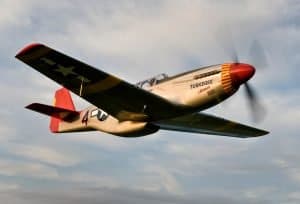What kinds of airplanes did the Tuskegee Airmen fly in training?
In primary flying training, the Tuskegee Airmen flew PT-17 and PT-13 biplanes, and occasionally P-19 monoplanes, on a grass strip at Moton Field. In basic flying training at Tuskegee Army Air Field, they flew BT-13 airplanes, and later AT-6s. In advanced flying training, also at Tuskegee Army Air Field, future fighter pilots flew AT-6 airplanes, and future bomber pilots flew twin-engine AT-10 airplanes. Later, the AT-10 planes were replaced by TB-25s. For transition training the future fighter pilots flew P- 40s and the future bomber pilots flew B-25s. Fighter pilots also flew P-39s and P-47s in transition training beyond Tuskegee.
What kinds of airplanes did the Tuskegee Airmen first fly in combat, and were they inferior to the airplanes the white pilots were flying?
The Tuskegee Airmen flew hundreds of patrol and attack missions for the Twelfth Air Force, flying P-40 and P-39 airplanes, before they were reassigned to the 15th Air Force to escort B-17 and B-24 heavy bombers, using P-47 and P-51 airplanes.
Curtiss P-40 Warhawk
The Tuskegee Airmen initially flew the Curtiss P-40 Warhawk. This was a prewar design and almost obsolete.
What kind of airplanes did the 332nd Fighter Group fly at first in combat?
Bell P-39 Airacobra
At first the 332nd Fighter Group flew P-39 airplanes in Italy. Those planes had the engine behind the pilot because the front to that airplane type included a cannon and its ammunition. The P-39 was very good at hitting targets on the ground or sea, but not very good against enemy fighters in air combat. At first the 332nd Fighter Group, because of its missions and its aircraft, had little opportunity to shoot down enemy airplanes.
The Russians built a large fleet of P-39s through Lend-Lease and favored this aircraft because it had a heavy automatic cannon firing through the propeller hub, and it was suitable for tank busting, but it was not suitable for air-to-air combat.
What kinds of airplanes did the 332nd Fighter Group use when it began flying its bomber escort missions?
When it began flying bomber escort missions, the 332nd Fighter Group flew P-47 Thunderbolt airplanes. Sometimes a P-47 was called a Jug. It had a very large air-cooled engine, and was excellent in a dive. Many Tuskegee Airmen liked the airplane because its large engine helped protect them from enemy fire facing them, and because the airplanes were less vulnerable than airplanes with water-cooled engines.
When did the 332nd Fighter Group begin flying P-51 Mustang airplanes in combat?
The 332nd Fighter Group began flying P-51 Mustang airplanes in combat during July 1944.
How did the P-51 Mustang compare with previous fighters flown by the 332nd Fighter Group in combat, the P-39 and the P-47?
Republic P-47 Thunderbolt
The 99th was equipped with Republic P-47 Thunderbolts in June and July 1944. This was an excellent aircraft and a very good dogfighter, especially at higher altitudes.
The North American Aviation P-51 Mustang is an American long-range, single-seat fighter and fighter-bomber used during World War II and the Korean War, among other conflicts. The P-51 could fly faster and farther than any previous fighters assigned to the group, but they were more vulnerable to enemy fire than the P-47 fighters, with their air-cooled engines.
Although first designed for the British as a medium-altitude fighter, the Mustang excelled in hedge-hopping strafing runs and long-range escort duty. It gained acclaim for firing on trains, ships and enemy installations in Western Europe. The P-51s could fly faster than other Allied fighters, but not faster than the German jets.
The North American prototype, NA-73X, was first flown on Oct. 26, 1940. At least eight versions of the Mustang were produced.
Source: Dr. Haulman, Retired Historian with the Air Force Historical Research Agency at Maxwell, AFB, Alabama.
We offer Dr. Haulman’s book The Tuskegee Airmen, An Illustrated History: 1939-1949 online at cafriseabove.org in the Store under Books: Tuskegee Airmen


